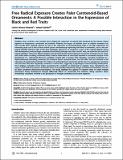Por favor, use este identificador para citar o enlazar a este item:
http://hdl.handle.net/10261/35385COMPARTIR / EXPORTAR:
 SHARE SHARE
 CORE
BASE CORE
BASE
|
|
| Visualizar otros formatos: MARC | Dublin Core | RDF | ORE | MODS | METS | DIDL | DATACITE | |

| Título: | Free radical exposure creates paler carotenoid-based ornaments: a possible interaction in the expression of black and red traits |
Autor: | Galván, Ismael CSIC ORCID ; Alonso-Álvarez, Carlos CSIC ORCID | Fecha de publicación: | 27-abr-2011 | Editor: | Public Library of Science | Citación: | PLoS ONE 6(4): e19403 (2011) | Resumen: | Oxidative stress could be a key selective force shaping the expression of colored traits produced by the primary animal pigments in integuments: carotenoids and melanins. However, the impact of oxidative stress on melanic ornaments has only recently been explored, whereas its role in the expression of carotenoid-based traits is not fully understood. An interesting study case is that of those animal species simultaneously expressing both kinds of ornaments, such as the redlegged partridge (Alectoris rufa). In this bird, individuals exposed to an exogenous source of free radicals (diquat) during their development produced larger eumelanin-based (black) plumage traits than controls. Here, we show that the same redlegged partridges exposed to diquat simultaneously developed paler carotenoid-based ornaments (red beak and eye rings), and carried lower circulating carotenoid levels as well as lower levels of some lipids involved in carotenoid transport in the bloodstream (i.e., cholesterol). Moreover, partridges treated with a hormone that stimulates eumelanin production (i.e., alpha-melanocyte-stimulating hormone) also increased blood carotenoid levels, but this effect was not mirrored in the expression of carotenoid-based traits. The redness of carotenoid-based ornaments and the size of a conspicuous eumelanic trait (the black bib) were negatively correlated in control birds, suggesting a physiological trade-off during development. These findings contradict recent studies questioning the sensitivity of carotenoids to oxidative stress. Nonetheless, the impact of free radicals on plasma carotenoids seems to be partially mediated by changes in cholesterol metabolism, and not by direct carotenoid destruction/consumption. The results highlight the capacity of oxidative stress to create multiple phenotypes during development through differential effects on carotenoids and melanins, raising questions about evolutionary constraints involved in the production of multiple ornaments by the same organism. | Versión del editor: | http://dx.doi.org/10.1371/journal.pone.0019403 | URI: | http://hdl.handle.net/10261/35385 | DOI: | 10.1371/journal.pone.0019403 | ISSN: | 1932-6203 |
| Aparece en las colecciones: | (MNCN) Artículos (IREC) Artículos |
Ficheros en este ítem:
| Fichero | Descripción | Tamaño | Formato | |
|---|---|---|---|---|
| journal.pone.0019403.pdf | 232,25 kB | Adobe PDF |  Visualizar/Abrir |
CORE Recommender
PubMed Central
Citations
20
checked on 10-abr-2024
SCOPUSTM
Citations
60
checked on 20-abr-2024
WEB OF SCIENCETM
Citations
56
checked on 22-feb-2024
Page view(s)
327
checked on 24-abr-2024
Download(s)
197
checked on 24-abr-2024

